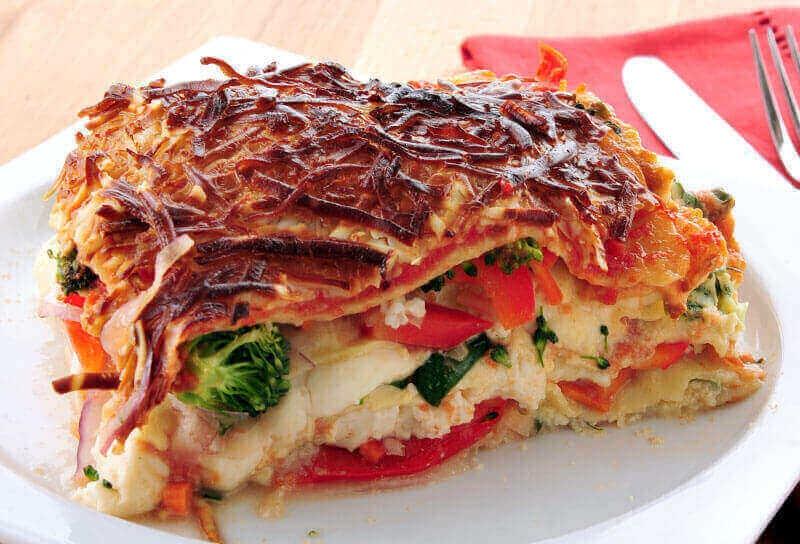Shrimp and Vegetable Lasagna
The smoking chamber method we first introduced with our Smoky Three Cheese Macaroni transforms this lasagna into something truly special. An abundance of vegetables are joined by shrimp, four cheeses and a raw tomato sauce.

- Apple wood chunks (optional)
- 1 pound large shrimp, 10 to 15 count, peeled and deveined
- Extra virgin olive oil
- Fine sea salt
- 2 eggs
- 15 ounces good quality ricotta (I use Miceli’s)
- 2 tablespoons freshly-squeezed lemon juice
- 3 cups coarsely-chopped spinach leaves
- 3/4 cup chopped flat leaf parsley
- 5 cloves garlic
- 1 carrot, peeled and cut into matchsticks
- 1 red bell pepper, cored and thinly sliced
- Florets from 2 heads broccoli, cut into small pieces, about 4 cups
- 1/2 red onion, thinly sliced
- 28 ounce can of whole, peeled Italian plum tomatoes
- 12 sheets fresh lasagna noodles (see note)
- 12 ounces queso fresco, crumbled
- 12 ounces fresh mozzarella (mozzarella balls packaged in water), sliced
- 8 ounces asiago, shredded
- Lasagna pan
- 2 aluminum roasting pans
- 3 cups apple wood chips, dry
Prepare the grill for direct grilling over high heat and with an indirect grilling zone at 500ºF. The direct zone is for grilling the shrimp. I like to do this over an apple wood fire. The indirect zone is for roasting the lasagna.
Lightly brush the shrimp with olive oil and season with salt. Quickly grill the shrimp over the hottest part of the fire, turning once. As soon as the flesh inside the cut where the shrimp was deveined begins to turn opaque, remove them from the grill. It is ideal to slightly undercook the shrimp since it will finish cooking in the lasagna. Reserve.
Beat the eggs in a large bowl. Add the ricotta, lemon juice, 1 tablespoon olive oil, 1/2 teaspoon salt, the spinach leaves, the parsley and the garlic. Mix well to combine. Reserve.
Place the tomatoes and all the liquid from the can into a blender or food processor. Add 3/4 teaspoon salt and blend until smooth. Voila – the perfect sauce for Neapolitan pizza, and for this lasagna.
Add a thin layer of tomato sauce to the bottom of the lasagna pan. Place 2 sheets of lasagna on top of that. Next, add 1/2 of the ricotta mixture and 2 more sheets of pasta. Then add a thin layer of sauce and 1/2 each of the carrots, onion, pepper, broccoli and queso fresco. Top this with another layer of pasta and the remaining 1/2 of the ricotta mixture. Add another layer of pasta to cover the ricotta, then a little sauce, the cooked shrimp and all of the mozzarella. More pasta is then topped with the remaining vegetables and queso fresco. Add the last layer of pasta topped with all of the remaining sauce. Sprinkle on the asiago cheese.
Place one of the aluminum roasting pans on the grill directly over the heat. Add wood chips inside the pan around its perimeter. Close the grill hood and wait 5 minutes or so for the chips to begin smoking. Be careful they do not ignite.
Once the chips are smoking, place the lasagna pan in the center of the roasting pan, surrounded by the wood chips. Slide the roasting pan over to the indirect zone and place the second roasting pan inverted over the top as a lid to seal in the smoke. Close the grill and roast the lasagna with indirect heat and wood smoke for 1 hour. Rotate once for even cooking. Check every 15 minutes or so to be sure the wood chips are still smoking. If not, slide the pan back over direct heat until they begin to smoke again and then return it to the indirect zone.
The lasagna should be bubbling with some vigor when the hour is up. If it is, go ahead and remove it from the grill. If not, it probably isn’t cooked through. There is a lot of moisture in the vegetables that needs to be cooked out. If the dish isn’t bubbling around the edges, remove the lasagna pan from the roasting pans and continue cooking with indirect heat for 20 to 30 minutes more.
When done, remove the lasagna from the grill and let rest for 15 minutes. Slice and serve.
Note: Each sheet of pasta should cover half of your lasagna pan. I use fresh lasagna that I buy in the refrigerated case at the market. You can use conventional, dried lasagna and follow the package instructions to boil it before assembling your dish. Or, you can use no-boil dried lasagna, but be sure the cooking time specified on the package is aligned with this recipe.

